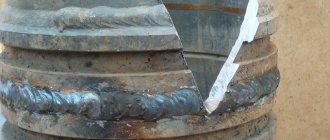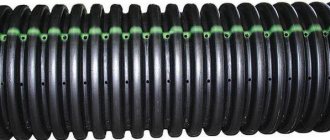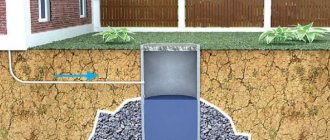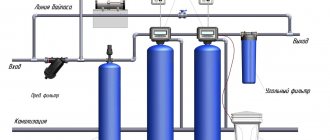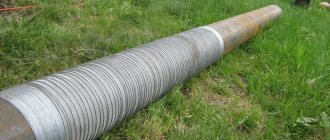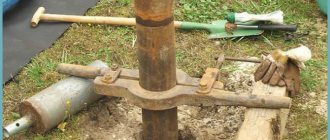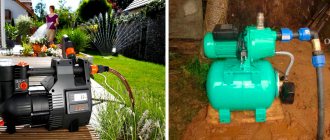When installing a well on his own plot of land, the owner, of course, wants to get the greatest benefit from it - so that there is enough water for his own needs, for irrigation, and for everything his heart desires. Simply put, so that it has high productivity or, as professionals say, has a high flow rate.
It would seem that everything is simple and clear - the wider the water intake shaft, the more water will flow into it, the greater the flow rate it will have. But is this really so? Is a wide well always more beneficial than a narrow one? You can get the answer to this question, as well as find out what the diameter of a water well depends on from this article.
Advantages and disadvantages of narrow trunks
Speaking of small wells, we mean trunks with a diameter of 50-110 mm. It is most profitable to use them in areas where the aquifer is located at least 9 meters from the ground surface. Water from such sources rises to the surface using standard pumps or portable pumping stations.
For wells with a width of 50 mm, self-priming centrifugal pumps are used. Such equipment can only be used at shallow depths. If the depth exceeds 9 meters, the pumping station simply will not be able to raise the water to the required level.
For diameters above 70 mm, three-inch pumps are suitable, characterized by high performance and no less high cost.
For wells with a diameter of 80-110 mm - pumping stations equipped with an ejector - a device that accelerates the process of rising water to the surface of the earth. With its help, you can pump out a large volume of water from the bottom of a well 50 meters deep in a short time.
Thus, small-diameter wells turn out to be the most profitable in terms of drilling and equipment used, but their maximum productivity is achieved only at a relatively shallow depth. However, if there are no chemical or processing plants nearby, and the pump is equipped with a good filter, the water taken will be quite clean and suitable for consumption.
Characteristics and scope of plastic pipes
After analyzing the available information, you can begin to select pipes. Let's see in what cases it is possible to use PVC pipes for wells.
Types of casing and production pipes made of plastic
The following types of plastic pipes are used to create wells:
- Made from HDPE - low-density polyethylene;
Low pressure polyethylene casing pipes
- Made from PP – polypropylene;
- PVC-U pipes for wells are made of unplasticized polyvinyl chloride.
All of them began to be used relatively recently, so there is no actual data on their service life yet. But the absolute non-susceptibility of plastic to corrosion suggests that it is in no way less than that of steel pipes, the service life of which is at least 50 years.
Note. Only pressure pipes should be selected as casing pipes for wells, regardless of the material they are made of. Gravity, that is, not designed for high external soil pressure, can be used to construct an internal production casing.
In what cases is the use of plastic pipes justified?
Plastic pipes cannot be used as casing for wells more than 60 meters deep, as well as for water intakes located in mobile and complex soils. Their strength is not enough for such loads, but they can serve as a production string in a well of any depth with a steel casing.
In principle, all of the above types of products can be used for these purposes, but the most attractive in terms of strength/cost ratio are uPVC pipes. Most often, plastic pipes are used for the construction of sand wells, since the service life of such water intakes is not very long, and “burying” an expensive steel column in the ground, designed for several decades, is an unjustified waste.
Another application option is an Abyssinian well made of plastic pipes. But when installing it, the column is not driven into the ground, but installed in a pre-drilled hole so as not to damage the integrity of the pipe.
Advice. When choosing the type of pipe connection to increase their length, give preference to the threaded one - it is the most reliable. Welding and installation in a socket do not provide adequate strength and tightness of the joints.
The photo shows a threaded pipe connection
Disadvantages and advantages
There are few disadvantages of such pipes, but they are significant. This is less strength than steel and insufficient resistance to mechanical stress. This does not allow their use in deep water intakes with significant soil pressure on the walls.
However, if you compare them with the same steel or asbestos-cement pipes, you cannot help but notice obvious advantages, which include:
- Absolute resistance to corrosion and aggressive environments;
- Resistance to chemicals used in the treatment of wells for their regeneration and disinfection;
- Durability resulting from the above properties, which can be more than 50 years, is the service life of steel pipes;
- High tightness of the connections, which guarantees the purity of the water in the well, not contaminated with soil particles and wastewater;
- Light weight, the ability to transport pipes to the site at a lower cost and install them with your own hands without the help of special equipment;
- Easy to install, especially with threaded connections;
The process of installing a plastic well
- Low cost of both the products themselves and their installation.
Such performance characteristics of plastic pipes are very attractive to consumers, which is why they are becoming increasingly popular among people who decide to organize their own autonomous water supply system for a country house or cottage.
Advantages and disadvantages of wide trunks
This “family” includes wells whose diameter exceeds 110 mm (the maximum value fluctuates around 170-200 mm). These dimensions allow the use of large-sized pumps with submersible ejectors, making it possible to extract water from deep-lying (up to 100 meters) formations. Wells of this depth are called artesian.
Large diameter well design
Drilling a wide well is a long and labor-intensive task, but in the end you will be able to get to the cleanest water at great depths. It is widely believed that the larger the intake bore, the more water will pass through the pump filter when pumped.
This statement is partly true, although size does not affect performance. A much more important role is played by the volume of water in the aquifer and the throughput of the filter used in the pump. To maintain high performance, the filter of pumping equipment requires periodic cleaning using a vibrating drill or special chemical additives. In addition, if you want to drill a wide well, get ready to spend a lot of money on construction and purchase of equipment.
Pipe diameter for a well: what does it affect and what is optimal?
What pipe diameter for the well will be optimal? It would seem that the larger the pipe, the greater the flow rate the well will receive. Is this really the case or are other factors influencing the well’s flow rate, and what pipe diameter should I choose to fully meet the water supply needs of a suburban area?
Which size is better?
The size of the well is not directly related to its productivity, so when planning, rely primarily on the depth of the aquifer (determined by special expertise) and your own financial capabilities. For a dacha or summer house, a diameter of 50 mm is best suited - this way you can save on drilling and pumping equipment, and at the same time get the necessary volume of water for irrigation and recreation.
If the well will be located near your place of permanent residence, it is better to use a larger diameter - provided that the water level is at a depth of below 50 meters. In this case, you will be able to quickly obtain the purest water, which does not have any harmful impurities and salts that have a negative effect on the body.
If groundwater lies at a depth of less than 30 meters, it is not advisable to dig a wide well. Otherwise, you will have to use large, expensive pumping stations, although simpler units can cope with water delivery.
Connection types
When arranging the casing, pipes are connected into a column in the following ways:
Socket threaded . The method is used when joining polymer or metal thin-walled pipes, while an internal thread is cut in the socket, and an external thread is cut in the section of the outer shell of the connected pipe.
Threaded. They are used in thick-walled metal and polymer pipes; the connected elements have external and internal threads; when they are joined, the walls are smooth on the outside and inside.
Coupling. The pipe elements to be connected have an external thread; they are screwed into a connecting coupling with an internal thread until the ends are connected.
Electric welding. Welding can be useful when joining thin-walled steel pipes where the cut threads would be too weak. The welding method is often used when installing steel casing - although it takes some time and requires good welding skills from a specialist, its use can be cost-effective (no need to purchase expensive heavy pipes with threads and thick walls).
Rice. 13 Steel and HDPE casing pipes
What determines the choice of section?
One of the main elements of well construction is the casing. It is a prefabricated structure. It usually consists of several long pipes made of metal profiles or polymer plastic, connected to each other using screw ties (less commonly, welding).
The main functional purpose of the casing is to prevent the walls of the well from collapsing and, as a consequence, contamination of the aquifer and pump filter.
The casing elements are sequentially driven into the drilled well to the required depth. The method allows you to achieve complete tightness of the shaft walls. The upper part of the last section is additionally reinforced with concrete.
The larger the diameter of the casing, the wider the range of pumping equipment that can be used to produce water, which can help increase the flow rate. If you do not need a large volume, you can use small-section pipes, having previously calculated (at least approximately) the amount of water consumed during the day.
- When water consumption is from 2 to 3 m3 per hour, a column with a cross-section of up to 80 mm will help meet the need;
- Volumes of 4 m3 and above can be provided by wells with casing diameters up to 125 mm.
Select the required diameter
So, choosing the right size should be based not only on water consumption, but also on many other parameters. Plastic risers have standard diameters: 80.90, 113, 125 and 140 mm.
Here you need to divide them all into small and large. So diameters of 80 and 90 mm are considered small, and 113 and 125 are considered large. The difference is this: a standard PVC casing drill for a well has a size slightly larger than 113 and 125, respectively. This leads to the formation of some free space between the walls of the pipe and the walls of the source, which must be filled with cement mortar or crushed stone.
As for small diameters, the drills for them have the same dimensions as the internal diameter, so first the product itself is placed, and drilling begins inside it.
Now one question remains: if such problems arise with large diameters, then why do them at all. The answer is simple - it's all about the pump. Often wells are more than 10 m deep. A submersible pump, which is large in size, is lowered to this depth.
Connecting thread of casing pipes
This leads to one simple conclusion: in the case when the depth of the source is more than 8 meters, then a casing water main with a diameter of 80 or 90 mm is used. If the depth is more than 8 meters, then it is better to use material with a size of 113, 125 or 140 mm, or even larger.
How to calculate the cross-section of a wellbore?
The above calculations are approximate. To know exactly what diameter to drill a well, you will need to make an accurate calculation taking into account the dimensions of the pumping equipment used and the depth of the natural source from which it is planned to lift water.
To do this, it is necessary, first of all, to calculate the amount of water consumed per hour, as mentioned above. If this figure is 3 m3 per hour, the best option would be a 75 mm pump without an ejector. Accordingly, the larger the volume, the larger the pump required. For example, if you consume 8 m3 per hour, you will need a pump with a diameter of 102 mm.
Based on the dimensions of the pump, the optimal cross-section of the wellbore is calculated. To do this, take the diameter of the selected pump - say, 102 mm, add it with the minimum gap between the outer pipe and the pump (the average value is 4 mm) and the value of the pipe wall thickness, multiplied by two.
For example, if we use a pipe with a wall thickness of 4 mm, the expression presented above will be as follows:
102 + 4 + 8 = 114
This way you will get the internal diameter of the casing, with which you will go to the hardware store. You can order pipes for its installation to order, or use standard sizes - 89, 108, 114, 127, 133 mm, etc.
Experienced specialists advise purchasing a pipe of a larger diameter - this way the pump inside the well will remain undamaged in the event of deformation of the column walls. For example, when the soil heaves in winter.
What materials are plastic casing structures made of?
Plastic products are increasingly being used for casing.
Products are made from the following materials:
- Polyvinyl chloride. This type of PVC pipe has many advantages. The liquid passing inside does not acquire an unpleasant odor. No plaque forms on the inner walls of the elements. Plastic casing pipes do not burst if water freezes in them. They also have threads to ensure a secure connection. The length of the parts is 3-5 m and depends on the diameter of the pipe.
- Low-density polyethylene (HDPE). The parts are characterized by increased density, resistance to loads and deformation during compression and tension. No plaque forms in the pipe cavity. They are resistant to chemicals and corrosion.
- Unplasticized polyvinyl chloride (UPVC). This type of product is more suitable for constructing casing columns. The products are made of durable material with low thermal conductivity, high quality connecting elements and a low expansion coefficient. PVC-U pipes do not allow underground runoff to reach the filtration area and are not subject to corrosion.
Polyvinyl chloride products are most often used. Due to its low strength, this type of pipe structure is used carefully, lowered vertically into the casing.
How to increase barrel size?
Sometimes it happens that the aquifer is depleted due to natural causes or under the influence of external factors that lead to displacement of soil layers. Most often this happens at shallow depths. Because of this, the owner of an autonomous source one fine day discovers that the pump has stopped pumping water and the precious well has turned into a useless hole in the ground.
There is only one way out - to dismantle the casing and deepen the well. And, as we remember, greater depth also requires an expansion of the diameter - so that later large-sized pumping equipment can be used. The best method is manual expansion using a cone drill or auger at a depth of 3-5 meters, after which you can use the rope-impact method.
- For this, a so-called drill-glass is used - a wide straight pipe with holes for greater maneuverability and a pointed end with teeth. You can buy a ready-made one or make it yourself - if the required diameter does not correspond to standard values.
A metal loop is welded to the bottom of the “glass”, to which the end of the cable is attached - the other is located on a drum placed at the top of the drilling rig. Drilling (and, at the same time, expanding the diameter) of a well occurs due to the fall of a glass from the height of this very tower - after which it is lifted up, cleared of soil and continued until its end hits the aquifer.
After the necessary expansion, the water intake is arranged in a similar way - pumping equipment is selected that corresponds to the depth of groundwater and a new casing is installed.
Types of casing pipes
There are several types of well pipes:
- Asbestos-cement ones have insufficient strength. Individual parts are difficult to fit together. Large holes are drilled for them, because... The pipe walls are made thicker for strength, which affects the cost of material and work, but increases reliability and increases the service life of the structure. Over time, asbestos begins to negatively affect the quality of drinking water.
- Steel ones are distinguished by their reliability and ability to withstand strong soil pressure. The material is expensive and is also susceptible to corrosion. Black steel is chosen for production because... Galvanized after some time releases harmful substances into the water. Due to the appearance of rust on steel, the quality of the liquid deteriorates.
- Plastic ones are often compared to steel ones. A plastic pipe has many advantages, including low price, but among the disadvantages of this type of product is the limitation on the depth of the well.
Types of casing pipes for wells.
The characteristics of materials must be taken into account when installing a well.
Differences from PVC pipes
The difference is that uPVC does not contain plasticizers, which are used in polyvinyl chloride to give the material plasticity.
Unplasticized polyvinyl chloride is harder and stronger than regular PVC. Experts recognize this modification as the most durable among all types of polymer materials.
Tips for choosing products
Before purchasing a PVC-U column, calculate the maximum water flow when all water appliances are turned on at the same time. Determine the required pump power and its dimensions. Based on this, the diameter of the future casing is selected.
In wells (the depth to the water table is more than 9-10 meters), submersible pumps are used, the smallest diameter of which is 76 mm. The casing should be wider (in this case 100 mm).
approximate cost
The price of the product depends on the cross-section, wall thickness, length of the outlet, and the volume of purchased products. They install it either per meter or per piece.
A casing pipe with a cross-section of 125 mm and a wall of 5 mm from a Russian manufacturer can be purchased for 372 rubles/linear. m. A casing with the same diameter, but a wall thickness of 7.5 mm will cost 553 rubles per meter.

